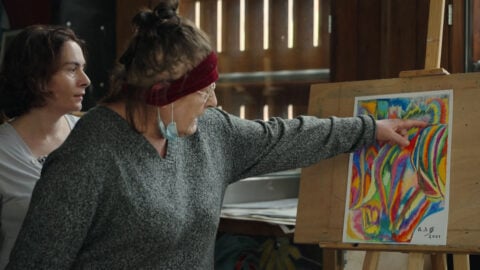Interview: Jackie Goss on The Observers
In Jackie Goss’s 2007 short Stranger Comes to Town, the director repeats the axiom that there are only two stories in the world: man goes on a journey, and stranger comes to town. In her latest work, The Observers, the town is the stranger—a mountaintop observatory—in a film that approaches everything from the location’s point of view.
The humans in The Observers are Dani Leventhal and Katya Gorker, Goss’s assistants who perform the duties of actual Mount Washington Weather Observatory scientists. They are in nearly every shot, frequently positioned in the exact center of the frame or in close-up. But the pair do not serve as guides for these wintry climbs. Rather, they are simply part of their surroundings, a subtle reminder that despite all of our excess frontal brain tissue, humanity is no more important than the rest of nature that passes in front of the lens.

There aren’t any explanations for the measurements that the two take, nor are their results arranged into a neat progression: the seismographic printout remains colored lines on paper; the poles stuck into ice on a typically blustery day remain floppy vertical lines. Our manmade constructions, our urge to understand (and therefore separate ourselves from) the rest of nature too are subsumed not by might but by fact.
The solitude that The Observers depicts, coupled with its ambient soundtrack (highlights include gusts on a particularly windy day and a voice on the radio), make the viewing experience akin to a staring contest. Under such sensory deprivation, the smallest details become heightened and aggressively expand to fill the cracks of even the most smartphone-addled attention span. Far from being video-art wallpaper, The Observers commands your focus, and creates a space for constructive thought.

Achieving so much with minimal effort is a bit of a departure for Goss. Her shorts are unapologetically verbose, using on-screen text in addition to interviews mainly comprised of computer-constructed graphics. There There Square (2002) took this essayistic impulse to its extreme, with text displayed around a shape-shifting map of the United States. (Nearly ten years on, the piece more resembles an experimental slideshow presentation than video work; that’s certainly not a dig at the piece, but a way of noting how technology changes meaning over time, even for filmmakers who intelligently work in new mediums.)
Watching The Observers, one almost wishes that Goss had tackled more traditional modes of filmmaking sooner. In the images she captures, the interplay between focus and blurriness, as well as light and dark, is truly masterful.
FILM COMMENT interviewed Goss about the making of The Observers.
What led you to change your style so radically? Do you think you’ll return to animation-based work?
I had been working with digital animation techniques almost exclusively for many years before The Observers and, after the birth of my son, something changed and I found it hard to work in that solitary way. All of my previous work seemed like animated book reports. I was longing for an adventure, and a way to work with other artists whom I admired. I think my head was in a motherhood fog which isn’t a bad thing for an artist to experience. I do plan to return to animation, but want to use those tools in ways that are as collaborative and experiential as I can.
What was the most difficult part about shooting this film, both in terms of climate and planning/envisioning how it would look?
One might expect that we would be cold shooting in 30 degrees below zero weather, but that wasn’t the hard part: we were well prepared for the weather in terms of our clothing and technologies. The relentless wind was exhausting though: I could stand five feet from Jesse or Holland and have to scream to be heard. Visibility was always a crapshoot: at any moment, we might be able to only see five feet in front of us, and then suddenly the cloud cover would break and blow away, and we could see the Atlantic 120 miles away. We finally made friends with this phenomenon, and I think some of the most beautiful stuff in The Observers features these reveals.
Why did you decide to use your assistants instead of the actual research scientists?
It was a combination of things: my desire to try my hand at fiction, even if only in the slightest way, to be as reactive and sensitive to the mountain and its weather as possible—to answer to it rather than to its “real” inhabitants, and to have more control over all the visual surfaces and textures of the film, including bodies, faces, and voices. Someone should make a documentary about the “real” observers, though. It would be riveting.
Do you have any upcoming projects planned?
Yes! I want to return to animation and make a piece about the history of the metric system and the “discovery” of the meter in France in the 18th-century. I also am planning another film set on the Old Course of the Saco River as it runs through Fryeburg, Maine.
The Observers had its theatrical premiere run at Anthology Film Archives in May and will show on June 9 at Northwest Film Forum.







